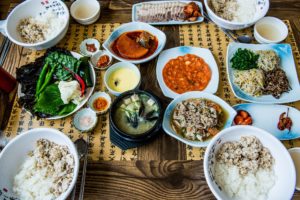
While it may not be as well known as its Chinese, Japanese, Thai, Vietnamese, or Indian counterparts, Korean food is still a popular cuisine out here in the west.
Kimchi over rice may not be for everyone, but it could be the perfect comfort food for you. While it may not be as well known as its Chinese, Japanese, Thai, Vietnamese, or Indian counterparts, Korean food is still a popular cuisine out here in the west. We’ve put together a list of the fundamental ingredients and elements of Korean cooking and foodways. Won’t you join us on this appetizing culinary journey?
Banchan: Let’s Start with the Sides
Side dishes make the meal come together. As important as entrees are, they wouldn’t be the same without their trusty companions. One of the hallmarks of Korean food is the banchan or the variety of side dishes included with a meal. When you sit down to eat at a Korean restaurant, you’ll notice that the banchan (small bowls of veggies, meats, and seafood) will hit your table first. Although it’s easy to think of them as appetizers, that isn’t exactly the point. Unlike Western dining routines, Korean dishes all arrive simultaneously.
Bowls of Rice and Much More
As you are probably aware, rice is a staple grain throughout the Asian world. As such, rice is the primary carbohydrate in play in a Korean diet and, by extension, on the table. Rice’s exalted position will be overtaken by noodles every so often, but this rarely ever happens. While low-carb substitutes do exist, in general, rice is the most important element of Korean cuisine. Everyone gets their own bowl of soup or stew, too.
Some of the Staple Ingredients
Now then, let’s look at some of the basic ingredients commonly used for Korean-style cooking. Food preservation has been an integral part of Korean cuisine for centuries; that’s why you’ll encounter so many things that have been pickled, fermented, or salted. Kimchi is the iconic spicy cabbage unique to Korea, but did you know that there are literally hundreds of other vegetables that could be used instead. Not all of them are extremely spicy. So what spices and sauces should you use to add some pop to the proceedings? Sesame oil, chili pepper paste (gochujang), chili pepper flakes (kochukaru), soybean paste (doenjang), soy sauce, garlic, ginger, and scallions.
Subtle Cultural Intricacies
Knives are not commonly used at a Korean restaurant. That’s because all of the items you order, including meat and seafood, will be cut into bite-sized pieces before they arrive at your table. Chopsticks are often sturdy enough to split and break up slabs of meat or entire fish dishes. Typically speaking, the meat dishes are braised or marinated for hours and hours; this makes the flesh even more tender. Unlike other countries around it, Korea relies on stainless steel chopsticks and long stainless steel spoons. One more thing – the traditional table is low, and everyone who gathers around it is supposed to sit on the floor.
Get All Your Asian Groceries at Lotte Plaza Market
Lotte Plaza Market is your one-stop-shop for all of your Korean and Asian grocery needs. With more than 10 Maryland and Virginia locations, this growing market is continually expanding and opening new markets to better serve our customers. Since we opened in 1976, our goal has always been to provide the best customer service and groceries to our customers. For answers to all of your questions, please email us at LottePlaza.com.
